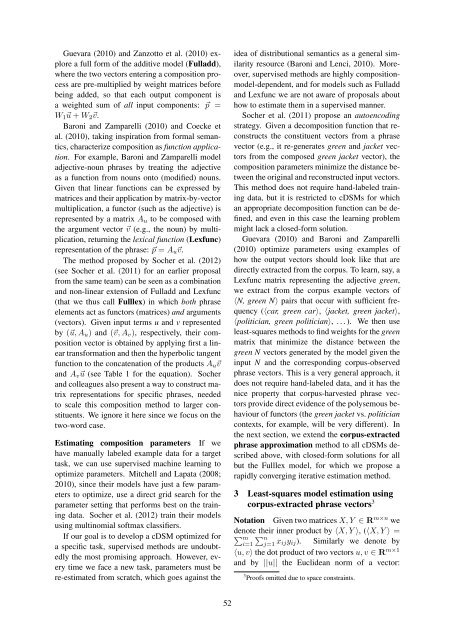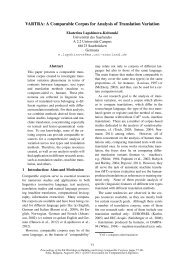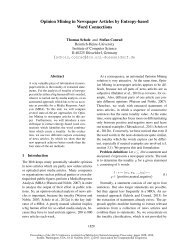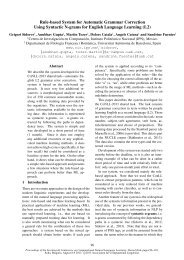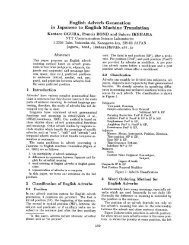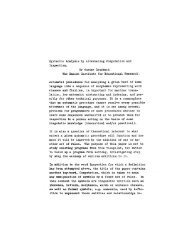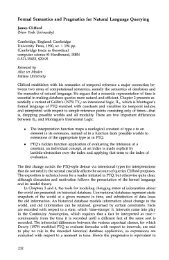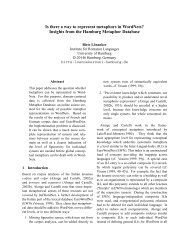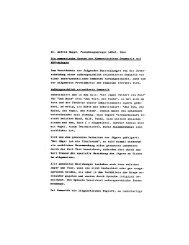Vector Space Semantic Parsing: A Framework for Compositional ...
Vector Space Semantic Parsing: A Framework for Compositional ...
Vector Space Semantic Parsing: A Framework for Compositional ...
You also want an ePaper? Increase the reach of your titles
YUMPU automatically turns print PDFs into web optimized ePapers that Google loves.
Guevara (2010) and Zanzotto et al. (2010) explore<br />
a full <strong>for</strong>m of the additive model (Fulladd),<br />
where the two vectors entering a composition process<br />
are pre-multiplied by weight matrices be<strong>for</strong>e<br />
being added, so that each output component is<br />
a weighted sum of all input components: ⃗p =<br />
W 1 ⃗u + W 2 ⃗v.<br />
Baroni and Zamparelli (2010) and Coecke et<br />
al. (2010), taking inspiration from <strong>for</strong>mal semantics,<br />
characterize composition as function application.<br />
For example, Baroni and Zamparelli model<br />
adjective-noun phrases by treating the adjective<br />
as a function from nouns onto (modified) nouns.<br />
Given that linear functions can be expressed by<br />
matrices and their application by matrix-by-vector<br />
multiplication, a functor (such as the adjective) is<br />
represented by a matrix A u to be composed with<br />
the argument vector ⃗v (e.g., the noun) by multiplication,<br />
returning the lexical function (Lexfunc)<br />
representation of the phrase: ⃗p = A u ⃗v.<br />
The method proposed by Socher et al. (2012)<br />
(see Socher et al. (2011) <strong>for</strong> an earlier proposal<br />
from the same team) can be seen as a combination<br />
and non-linear extension of Fulladd and Lexfunc<br />
(that we thus call Fulllex) in which both phrase<br />
elements act as functors (matrices) and arguments<br />
(vectors). Given input terms u and v represented<br />
by (⃗u, A u ) and (⃗v, A v ), respectively, their composition<br />
vector is obtained by applying first a linear<br />
trans<strong>for</strong>mation and then the hyperbolic tangent<br />
function to the concatenation of the products A u ⃗v<br />
and A v ⃗u (see Table 1 <strong>for</strong> the equation). Socher<br />
and colleagues also present a way to construct matrix<br />
representations <strong>for</strong> specific phrases, needed<br />
to scale this composition method to larger constituents.<br />
We ignore it here since we focus on the<br />
two-word case.<br />
Estimating composition parameters If we<br />
have manually labeled example data <strong>for</strong> a target<br />
task, we can use supervised machine learning to<br />
optimize parameters. Mitchell and Lapata (2008;<br />
2010), since their models have just a few parameters<br />
to optimize, use a direct grid search <strong>for</strong> the<br />
parameter setting that per<strong>for</strong>ms best on the training<br />
data. Socher et al. (2012) train their models<br />
using multinomial softmax classifiers.<br />
If our goal is to develop a cDSM optimized <strong>for</strong><br />
a specific task, supervised methods are undoubtedly<br />
the most promising approach. However, every<br />
time we face a new task, parameters must be<br />
re-estimated from scratch, which goes against the<br />
idea of distributional semantics as a general similarity<br />
resource (Baroni and Lenci, 2010). Moreover,<br />
supervised methods are highly compositionmodel-dependent,<br />
and <strong>for</strong> models such as Fulladd<br />
and Lexfunc we are not aware of proposals about<br />
how to estimate them in a supervised manner.<br />
Socher et al. (2011) propose an autoencoding<br />
strategy. Given a decomposition function that reconstructs<br />
the constituent vectors from a phrase<br />
vector (e.g., it re-generates green and jacket vectors<br />
from the composed green jacket vector), the<br />
composition parameters minimize the distance between<br />
the original and reconstructed input vectors.<br />
This method does not require hand-labeled training<br />
data, but it is restricted to cDSMs <strong>for</strong> which<br />
an appropriate decomposition function can be defined,<br />
and even in this case the learning problem<br />
might lack a closed-<strong>for</strong>m solution.<br />
Guevara (2010) and Baroni and Zamparelli<br />
(2010) optimize parameters using examples of<br />
how the output vectors should look like that are<br />
directly extracted from the corpus. To learn, say, a<br />
Lexfunc matrix representing the adjective green,<br />
we extract from the corpus example vectors of<br />
〈N, green N〉 pairs that occur with sufficient frequency<br />
(〈car, green car〉, 〈jacket, green jacket〉,<br />
〈politician, green politician〉, . . . ). We then use<br />
least-squares methods to find weights <strong>for</strong> the green<br />
matrix that minimize the distance between the<br />
green N vectors generated by the model given the<br />
input N and the corresponding corpus-observed<br />
phrase vectors. This is a very general approach, it<br />
does not require hand-labeled data, and it has the<br />
nice property that corpus-harvested phrase vectors<br />
provide direct evidence of the polysemous behaviour<br />
of functors (the green jacket vs. politician<br />
contexts, <strong>for</strong> example, will be very different). In<br />
the next section, we extend the corpus-extracted<br />
phrase approximation method to all cDSMs described<br />
above, with closed-<strong>for</strong>m solutions <strong>for</strong> all<br />
but the Fulllex model, <strong>for</strong> which we propose a<br />
rapidly converging iterative estimation method.<br />
3 Least-squares model estimation using<br />
corpus-extracted phrase vectors 3<br />
Notation Given two matrices X, Y ∈ R m×n we<br />
∑<br />
denote their inner product by 〈X, Y 〉, (〈X, Y 〉 =<br />
m ∑ n<br />
i=1 j=1 x ijy ij ). Similarly we denote by<br />
〈u, v〉 the dot product of two vectors u, v ∈ R m×1<br />
and by ||u|| the Euclidean norm of a vector:<br />
3 Proofs omitted due to space constraints.<br />
52


